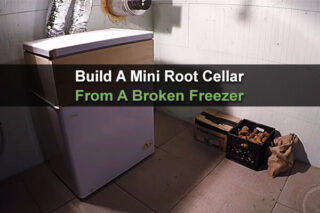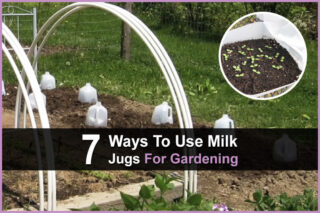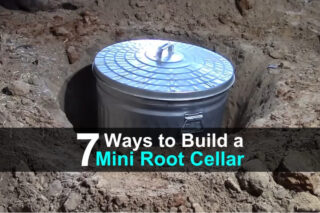Estimated reading time: 6 minutes
Root cellars used to be in every backyard until refrigeration became a thing. They are still common among farmers and people that want to store food in a cool, dark place. Like the name implies, root cellars are ideal homes for potatoes, onions, carrots and other root crops. Putting shelves in the root cellar allows you to store your home-canned goods as well.
One of the reasons preppers love root cellars is because they are free. They don’t rely on electricity and can be used throughout the year to store fresh fruits and veggies at the perfect temperature. It’s like a huge bottom drawer in the fridge but au naturel. The earth provides the perfect temperature and moisture to keep your root crops fresh for months.
While it’s fairly simple to build a root cellar, there are some things you want to avoid doing. You don’t want to put all your hard-earned food into a cellar and lose it because of a silly mistake. Food is more valuable than gold these days. Every ear of corn and potato counts.
Like this post? Don't Forget to Pin It On Pinterest!
Airflow/Ventilation
Unlike your refrigerator, a root cellar needs plenty of ventilation. Imagine leaving apples in a sealed box and opening it a month later. The apples are going to look like a science experiment. Produce gives off ethylene gas as it sits. It’s why you don’t want your apples piled on top of one another, they will rot. The gas and humidity lead to mold and mildew.
That phrase about it only taking one bad apple to ruin a bushel is based in fact. A root cellar cannot be airtight. It needs to have ventilation to circulate the air to keep the humidity down.
No Bright Lights
Root cellars are effective because they are dark. Light is an enemy in the world of food storage. You can have a light for obvious reasons, but it should be a dim light and only on when you are in the cellar. Use a flashlight if you need extra directed light. It’s a little spooky, but it’s worth it to keep your food fresh longer.
Also, you don’t want to be going in and out of the cellar every day. Every time the door is opened, it let’s sunlight in and disrupts the natural temperature. Throwing a burlap sack over the produce is one way to protect it from the light for those times you do need to visit the cellar.
Proper Storage Space
You might have the ability to build a nice walk-in cellar with plenty of space and shelves or you might only have a small cellar big enough to turn around in. The key is keeping fruits and veggies apart. You don’t want apples mingling with potatoes or onions with berries. Fruit are the culprits of ethylene gas being released.
It’s important not to mix and match your produce. You can use a pallet or a sheet of plywood to create different storage spaces. Some people choose to have two separate cellars: one for fruits and one for vegetables. If you can swing it, go for it. If you have to store fruits and veggies in the same cellar, you do run the risk of reducing the storage time for veggies.
Proper Storage Practices
People often make the mistake of assuming they can just toss their fruits and veggies in a cellar and forget about them. Unfortunately, that doesn’t work. Produce should be spaced out to avoid touching one another. When possible, wrap apples and other fruits in newspaper to cut down on the escape of gas that speeds up the rotting process.
Never wash the dirt from your root crops. The dirt that clings to your potatoes and onions is another layer of protection from the elements that speed up the rotting process. With that said, don’t put muddy veggies in the cellar either. That is introducing too much moisture. And you can’t just forget about the cellar.
It’s important you check on things at least once a week. Look for signs of spoilage among the produce. A leaky, damp potato should be pulled immediately to keep it from rotting the rest of the potatoes.
An old trick that used to be very common was to use old (or new if you’re inclined) nylons aka pantyhose to store onions. Drop an onion in and tie a knot before dropping in another one and hang the string from a shelf or behind the cellar door.
This keeps the onions separated from one another and makes sure there is plenty of air flow to keep them from getting soft and spoiling. When you need an onion, cut off the bottom just below the knot and leave the rest.
Humidity
It’s a good idea to keep some kind of weather device in your root cellar. This will allow you to monitor the temperature and humidity level in the cellar. Hopefully, you’ve chosen a prime location for your cellar that isn’t close to the water table.
Too much moisture and the entire contents of your root cellar could be wiped out in a matter of days. An earth floor and earth walls provide the perfect amount of humidity in most cases. If you’ve had excessive rain, you’ll need to keep an eye on things.
You can also end up with a cellar being too dry. If the humidity is too low, your produce will shrivel. You can help keep things moist with a gentle spritz of water over the produce. You have to be careful not to let it get too wet. This is why it is critical you have a humidity monitor in the cellar to catch problems before they can become severe enough to destroy your food.
Shelving
If you are inclined to use shelving, make sure it does not interfere with the airflow in the cellar. Shelving is a great way to get more bang for your buck in the cellar but don’t let it be the thing that ruins your food by blocking the natural air circulation.
Some things like squash and pumpkins can be put on shelves but the same storage rules apply—airflow. They shouldn’t be touching. Place foods like potatoes closer to the bottom where it’s colder. Tomatoes should be on the top where it’s a little warmer.
Stinky Veggies
There’s a reason we put baking soda in our fridges—it absorbs the odors. When you have a lot of different kinds of produce living in the same space, there’s going to be some odors that are not necessarily pleasant. Cabbage, onions and turnips are big offenders. Fruit will absorb the odors and give it a funky taste.
Flooring
A root cellar doesn’t necessarily need a floor. The goal is to let the earth do the work. Never put a cement floor in your cellar. That’s a basement. It traps the natural humidity below the cement.
In the summer, the cement will retain heat and increase the temperature in the root cellar. The raw, exposed earth provides the humidity the cellar needs and keeps things cool. Some people feel better putting a pallet down. That can work but it needs to have gaps in the wood to allow the air to move. You could put down gravel if necessary.
Root cellars come in all shapes, sizes and styles. It doesn’t matter what kind of root cellar you have. The only thing that truly matters is avoiding the mistakes mentioned above.
Like this post? Don't Forget to Pin It On Pinterest!
You May Also Like:












